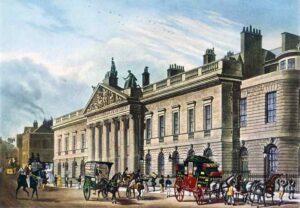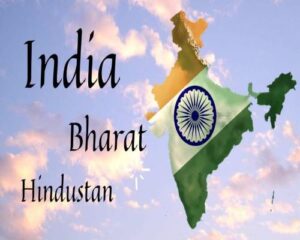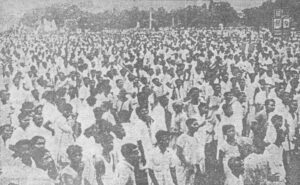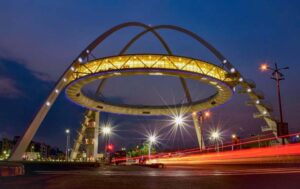A visit to Kolkata is incomplete without the visit to Dakshineswar temple. The glorious temple is dedicated to the divine mother Kali. It is situated on the bank of the river Ganga in the north of Kolkata at Dakshineswar in the North 24 Parganas district of West Bengal.
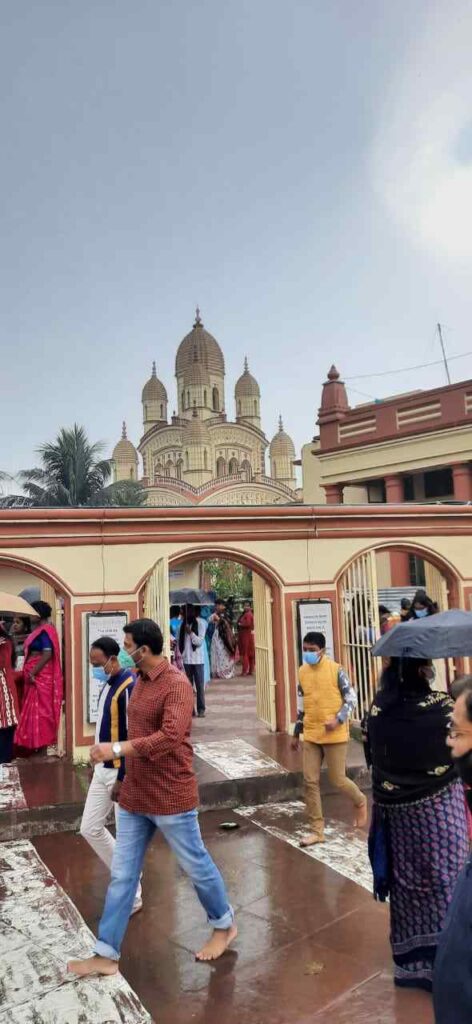
The presiding deity worshiped in the temple is Bhavatarini, a form of Adya Kali. The priceless pieces of jewelry adorn the deity.
While the spiritual history of this temple has the mystic sage, the socio-political history of the temple is quite gripping too.
History of Dakshineswar Kali Temple
Rani Rashmoni built this magnificent temple in 1855. She was born in a poor family in the small village of Halisahar in Bengal. As destiny had it, she became the wife of a very wealthy Zamindar from Jaan Bazaar, Kolkata. The philanthropist activities of Rashmoni made her so famous that still, she is revered as a model of intelligence, compassion, and character in Bengal.
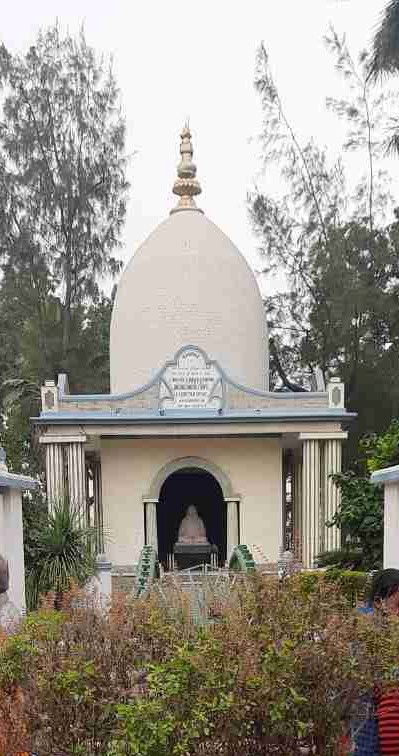
According to traditional accounts, celestial exposure led Rani to create this renowned Dakshineswar temple.
It is said that in the year 1847 Rani Rashmoni was making arrangements to go upon a pilgrimage to the sacred Hindu city of Kashi(present day Varanasi). She’d had a long-held desire to make this pilgrimage.
The elaborate arrangements were almost complete. The Rani was to be accompanied by her three daughters and their husbands, as well as other relatives and a slew of servants. A total of 25 barges had been commissioned.
Those days, a famine had cast a dark shadow over the entire country at the time, and people were in a state of panic. The agonizing cries of thousands of starving people, as well as reports of hundreds of deaths from starvation, agitated the Rani. While taking her daily bath in the Ganges, she witnessed the unspeakable plight of the starving people.
Rani had already begun her pilgrimage and had arrived in Dakshineswar. While on the boat, she had a vision of the Divine Mother goddess Kali in a dream that night. The Goddess told her she didn’t need to go to Kashi. Instead, a beautiful temple should be constructed on the bank of the Ganges where the Goddess will be installed, and regular worship and services will be provided. The Goddess assured her, ‘I will manifest myself in the stone image and will accept your daily worship and food offering regularly.’
Profoundly affected by the dream, Rani immediately called off the pilgrimage. Food and other supplies were then distributed to the famine-stricken people from the barges. Also, Rani contributed additional funds to their relief efforts.
The Land Of Dakshineswar
There is a saying, ‘The western bank of the Ganges is as holy as Varanasi.’ Rashmoni had great faith in this and searched extensively along the Ganges’ western bank, but she couldn’t acquire a plot anywhere.
Even with the promise of large sums of money, the Rani could not secure any foothold there due to the stubborn opposition of the influential upper caste communities. She was compelled to search for land on the eastern bank of the Ganges, and she finally purchased the 3000-acre plot where the present temple complex stands.
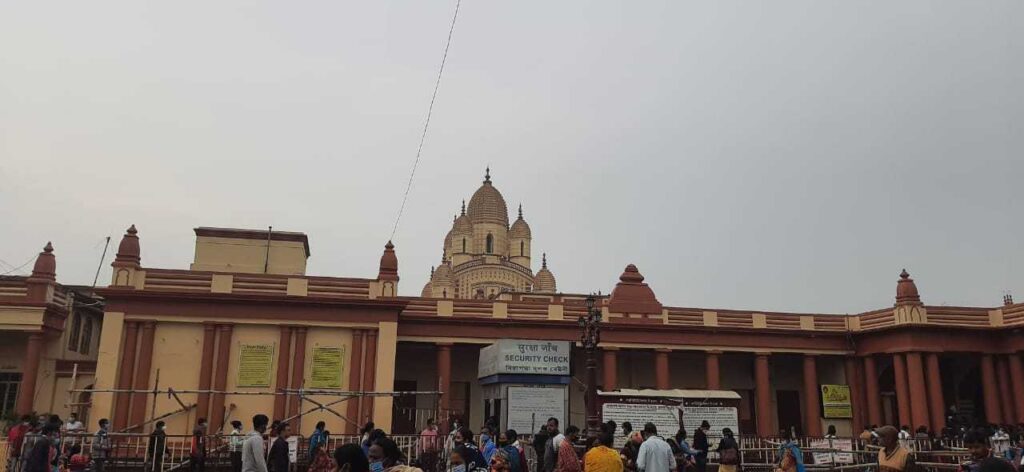
The massive temple complex was constructed between 1847 and 1855. The 20-acre plot was bought from an Englishman, Jake Hastie. Another part was an old Muslim burial ground shaped like a tortoise, considered befitting for the worship of Shakti according to Tantra traditions. Dakshineswar temple construction took eight years and nine hundred thousand rupees to complete.
Installation of Maa Kali
But, problems did not end here for Rani Rashmoni. Brahmins refused to become priests at a temple constructed by a woman from a lower caste.
She discussed the problem at length with the scholars, but none could solve her problem. A poor Brahmin scholar, Ramkumar Chattopadhyay, suggested that donating the temple to a Brahmin priest could solve the issue.
It was decided that the temple will be dedicated in the name of Rani Rashmoni’s Guru and Ramkumar was announced as the head priest.
The idol of Goddess Kali was installed on the Jagannath Deva Snanyatra day with a grand splendor on 31 May 1855 at the temple.
More than a lakh Brahmins from all over the country were invited to attend the auspicious occasion. Many intellectuals of shastras (scriptures), Brahmin pundits, and celebrated scholars arrived from distant places.
Soon, Ramkumar’s younger brother Gadai or Gadadhar (later known as Ramakrishna Paramahamsa) moved in to assist him. Ramakrishna took over the job of head priest next year, after Ramkumar’s death.
Dakshineswar Temple Architecture
The main temple is 46 square feet in size and stands on a high platform with a flight of stairs, giving the temple a height of more than 100 feet.
The temple compound, apart from the nine-spired main temple(navaratna temple), contains a large courtyard surrounding the temple, with rooms along the boundary walls.
There are twelve identical Shiva temples built in the typical aatchala Bengal architecture, on either side of the ghat on the Hooghly river. Shiva lingas made of black stone can be found in each of the temples.
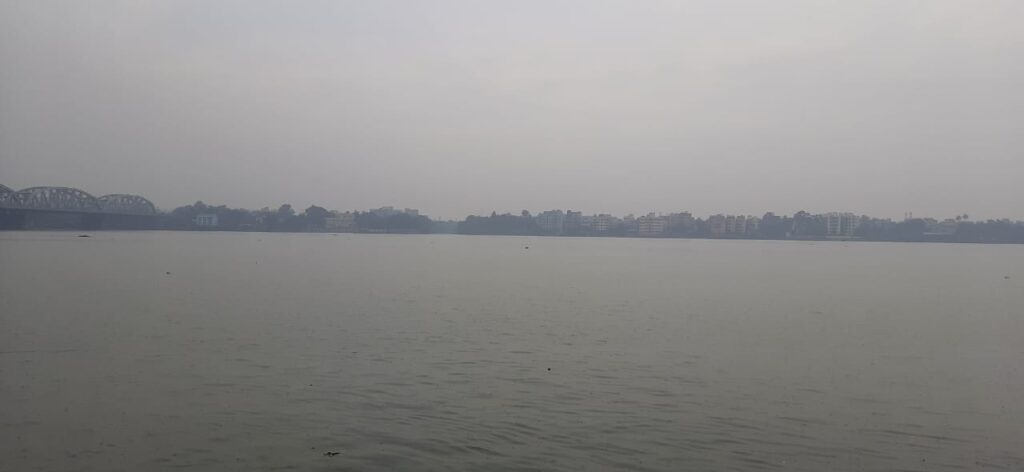
In Radha Kanta temple, a silver throne rests with a 21 and a half inches idol of Lord Krishna and 16 inches idol of Radha.
The original idol of Lord Krishna, which was replaced after the leg of the idol broke, is housed in a room next to it. Sri Ramakrishna himself had repaired the idol.
Ramakrishna, along with his wife Sarada Devi, stayed on the south side of the Nahabat (music room) in a small room on the ground floor that is now a shrine dedicated to her.
There is a bathing ghat on the river and a shrine dedicated to Rani Rashmoni.
Rani Rashmoni’s devotion, hard work, and perseverance were instrumental in the temple’s construction. She lived for only five years and nine months after the inauguration of the temple. She fell seriously ill in 1861. Recognizing that her death was imminent, she decided to leave the temple trust the property she had purchased in Dinajpur (now in Bangladesh) as a legacy for the temple’s maintenance. Rashmoni handed over the property on 18 February 1861 and died the next day.
The Glorious Ramakrishna Paramahamsa
It was the thirty years of Sri Ramakrishna’s God-intoxicated life that brought fame and pilgrims to the temple and elevated it to one of the world’s most important pilgrimage sites. Devotees would crowd to see Ramkrishna performing puja as they wanted to view his love and devotion for Goddess Kali.
Ramakrishna preached universal brotherhood, and soon Swami Vivekananda and many stalwarts became his disciples.
At the age of 23, Ramakrishna married Saradamoni of Jairambati, whom he thought would be his ideal life companion.
Ramakrishna even worshipped Saradamoni in the same way he worshipped the Goddess Kali, known as Shorshi puja.
After Ramakrishna died in 1886, Saradamoni preached the teachings of Ramakrishna for the rest of her life.
How to Visit Dakshineswar Temple
The Dakshineswar Temple is located 13 km away from Kolkata and 19 km from Howrah. In the earlier days, visiting by boat was one of the most preferred ways to reach the temple. Even, now also for a special treat, one can rent a boat and arrive at the temple’s bathing ghat.
But, commuting by road or train has become the preferred way for pilgrims to reach Dakshineshwar. A parking facility is available within the temple compound for private cars. Many private and state buses ply on this route. Dakshinewar metro and the local train station are also within walking distance.
Dakshineswar Temple Timing
Morning: 6:30 am to 12.30 pm
Evening: 3:30 pm to 7:30 pm
The timings changes according to season.
Dakshineswar continues to attract a huge number of devotees all year and is one of the most visited places of worship in Kolkata.


